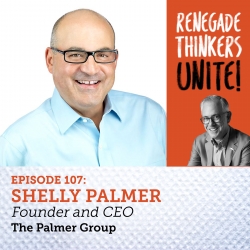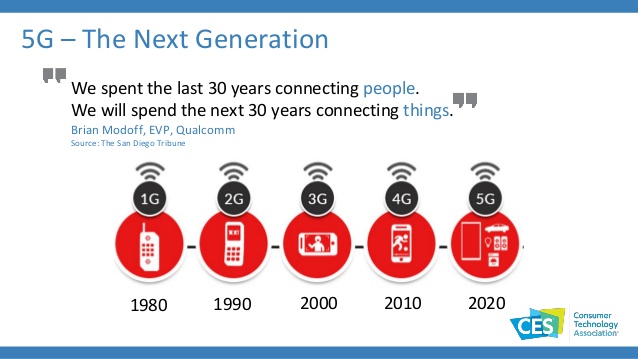I had the pleasure once again of attending Shelly Palmer’s annual kick-off breakfast where he level-sets our expectations for CES two hours before the tech halls open. Shelly is a consumer tech expert and leads the Palmer Group; comments on Fox 5 in NYC, CNN, and CNBC; writes a weekly column in Advertising Age; composes music; and he’s a Renaissance Man who’s a generous sharer of knowledge with a great sense of humor and humanity.
Shelly is one of my trusted touchpoints for all-things-consumer-tech.
 His message at the start of #CES2019: this year, the show is about connectivity and partnership. You can’t do everything yourself. We need interoperability and connectivity, and that connectivity also means interpersonal connections.
His message at the start of #CES2019: this year, the show is about connectivity and partnership. You can’t do everything yourself. We need interoperability and connectivity, and that connectivity also means interpersonal connections.
That resonates big for health/care, doesn’t it?
When he used the word “interoperability,” I nearly fell out of my chair because that’s such a hot button in health care IT right now.
Digging deeper into some of the big trends, Shelly’s observations will also ring authentic to health/care stakeholders…
AI is everywhere at CES. But it’s not necessarily useful for everything. As my friends at #JPM this week are hearing in San Francisco, AI is part of virtually every biotech and med-tech story. Here at CES, it’s the same buzzword to look out for. Shelly strongly recommends we kick the tires on those AI mentions, asking, “why are you using it?” Sometimes, all you need are some statistical analysis, not necessarily machine learning or cognitive computing.
Having said that, there sound use cases of AI at CES — Shelly pointed to some, “amazingly good purpose-built tools” like Alexa voice services with auto speech recognitiona nd natural language understanding.
These skills are already helping make health care better for providers in medical practice and consumers and caregivers at home for aging support, medication adherence, and mental health.
 Another buzzword at CES this year, as last, is “5G.” This fast network technology is very promising, but it’s not here yet. When it arrives, 5G will indeed be game-changing, Shelly projects, knowing that “the speed of information is directly related to economic success.” Information asymmetry is one of the most primitive instincts we have, he noted.
Another buzzword at CES this year, as last, is “5G.” This fast network technology is very promising, but it’s not here yet. When it arrives, 5G will indeed be game-changing, Shelly projects, knowing that “the speed of information is directly related to economic success.” Information asymmetry is one of the most primitive instincts we have, he noted.
The rest of the CES story for 2019 is positive, Shelly optimistically continued. “We are in a world of incremental change, everywhere.” Last year, he said, was a year of iteration, not innovation. But reflecting on that walking this year’s halls of shiny new things, Shelly said that in his opinion, “iteration is a humble form of innovation.”
Making things “slightly better” is happening: for example, testing longer battery life, improving camera technology, and testing hardware security are among the marginal improvements that can make our tech experiences so much better.
Walking through the Sands marketplace, which is where most of my steps will be taken, will show me new things in wearable tech, fitness, health, baby tech, and smart homes. “It looks like a 7th century bazaar,” Shelly described,”a vibrant marketplace with people telling you that ‘my’ same thing is better than the next booth’s same thing.” This “bazaar” is in fact the real market working on the supply side.
“Don’t be sad there is not a lot of bright shiny new stuff out there,” he asserted. “Rejoice in the fact that what you are seeing is the future unfolding in front of you.”
Health Populi’s Hot Points: Shelly’s intro to #CES2019 resonated with my health/care lens on this meeting. Those of us who have worked in the health care ecosystem for some years know that the industry doesn’t change fast. The whole concept of Clay Christensen’s disruptive innovation is taken with large grains of salt, because there are so many barriers to change in our field: regulation, fragmented care delivery, clinician workflow, medical cultures, payment/reimbursement, and increasingly the growing role of patient-as-consumer-as-payor with new muscles to engage with, or reject, legacy health care players (hospitals, doctors, pharma).
On the pure tech side, say for AI and 5G, the technology is falling into place soon; but that’s easier compared with everything that’s needed to commercialize and scale adoption. Think about building towers for 5G’s faster communications capability, or new business rules and roles. And incumbents in these new situations can be out-run by new entrants who can define these new business rules and roles necessary for conducting business that use these technologies.
That certainly rings true for the evolving retail health care landscape, as CVS and Aetna come together, Google grows in health and medicine, and Amazon spreads tentacles throughout the health ecosystem.
 Ultimately, though, trust is a critical currency, and especially in health care.
Ultimately, though, trust is a critical currency, and especially in health care.
As Shelly put it, we in industry have a responsibility. “Trust is the most sacred asset that any organization has,” he called out.
True enough, in the latest Gallup Poll on honesty and ethics in professions in America, the leaders in trusted roles were nurses, pharmacists and doctors. Our health care human capital are trusted citizens in the U.S. This cannot be over-stated or over-valued. The best new tech innovations in health and medical care should and must be coupled with empathy on the human side and respect for patients and providers alike.
In Shelly’s consumer-tech world, he cites demand-side disruption — that is, markets driven from consumers at the grassroots upward to the supply side.
And so in the evolving health care ecosystem, as patients take on the roles of payor and clinical decision maker, technology-based solutions need to deliver enchanting experience, privacy by design, and empowering workflows.
The post Shelly Palmer De-Hypes CES 2019 & Has Lessons for Health/Care appeared first on HealthPopuli.com.
Shelly Palmer De-Hypes CES 2019 & Has Lessons for Health/Care posted first on http://dentistfortworth.blogspot.com
No comments:
Post a Comment